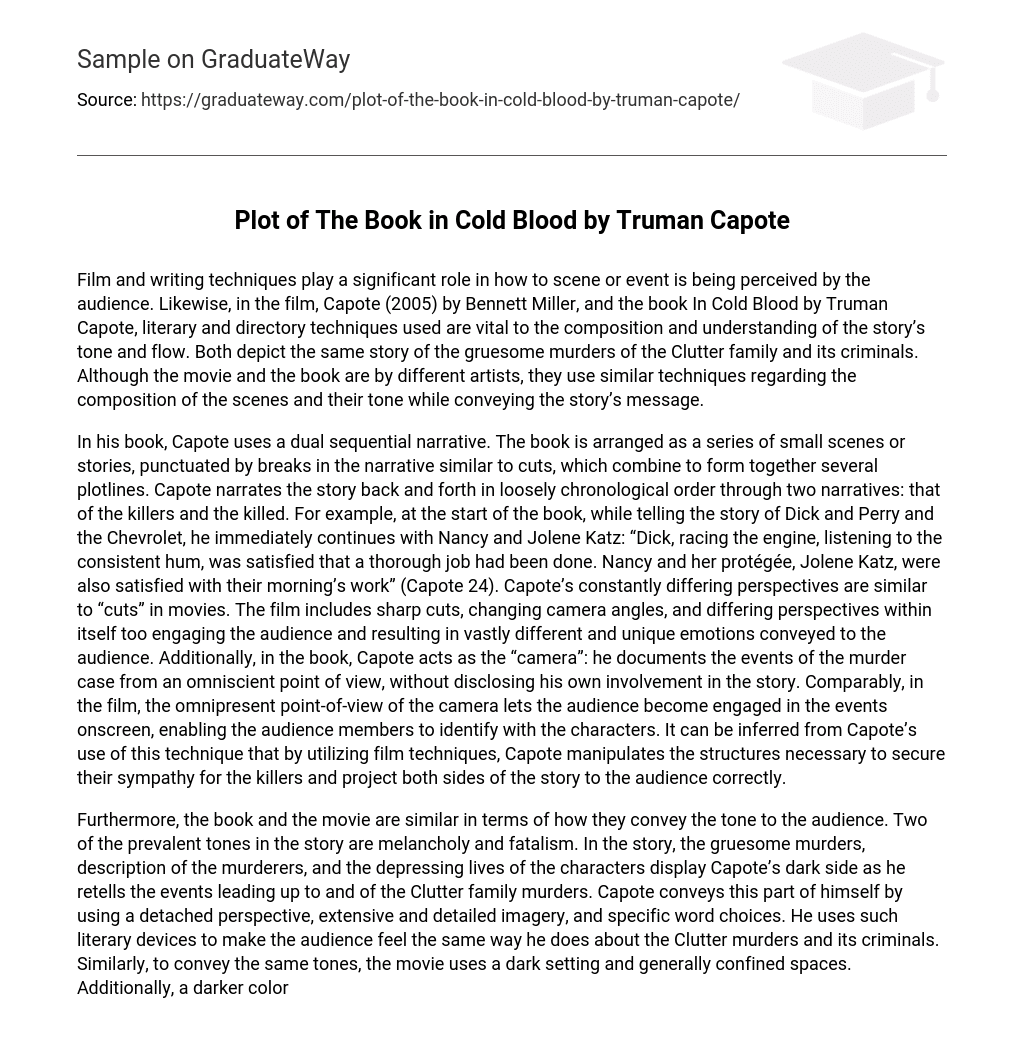Film and writing techniques play a significant role in how to scene or event is being perceived by the audience. Likewise, in the film, Capote (2005) by Bennett Miller, and the book In Cold Blood by Truman Capote, literary and directory techniques used are vital to the composition and understanding of the story’s tone and flow. Both depict the same story of the gruesome murders of the Clutter family and its criminals. Although the movie and the book are by different artists, they use similar techniques regarding the composition of the scenes and their tone while conveying the story’s message.
In his book, Capote uses a dual sequential narrative. The book is arranged as a series of small scenes or stories, punctuated by breaks in the narrative similar to cuts, which combine to form together several plotlines. Capote narrates the story back and forth in loosely chronological order through two narratives: that of the killers and the killed. For example, at the start of the book, while telling the story of Dick and Perry and the Chevrolet, he immediately continues with Nancy and Jolene Katz: “Dick, racing the engine, listening to the consistent hum, was satisfied that a thorough job had been done. Nancy and her protégée, Jolene Katz, were also satisfied with their morning’s work” (Capote 24). Capote’s constantly differing perspectives are similar to “cuts” in movies. The film includes sharp cuts, changing camera angles, and differing perspectives within itself too engaging the audience and resulting in vastly different and unique emotions conveyed to the audience. Additionally, in the book, Capote acts as the “camera”: he documents the events of the murder case from an omniscient point of view, without disclosing his own involvement in the story. Comparably, in the film, the omnipresent point-of-view of the camera lets the audience become engaged in the events onscreen, enabling the audience members to identify with the characters. It can be inferred from Capote’s use of this technique that by utilizing film techniques, Capote manipulates the structures necessary to secure their sympathy for the killers and project both sides of the story to the audience correctly.
Furthermore, the book and the movie are similar in terms of how they convey the tone to the audience. Two of the prevalent tones in the story are melancholy and fatalism. In the story, the gruesome murders, description of the murderers, and the depressing lives of the characters display Capote’s dark side as he retells the events leading up to and of the Clutter family murders. Capote conveys this part of himself by using a detached perspective, extensive and detailed imagery, and specific word choices. He uses such literary devices to make the audience feel the same way he does about the Clutter murders and its criminals. Similarly, to convey the same tones, the movie uses a dark setting and generally confined spaces. Additionally, a darker color scheme is used throughout the movie, similar to Capote’s imagery, mainly because the darker color schemes, including grey and black tones, represent mourning, and so set a melancholic and despondent tone. To sum up, both the movie and the book utilize similar techniques while conveying the tone to the audience, composing the elements of events, and using character-specific perspectives.





